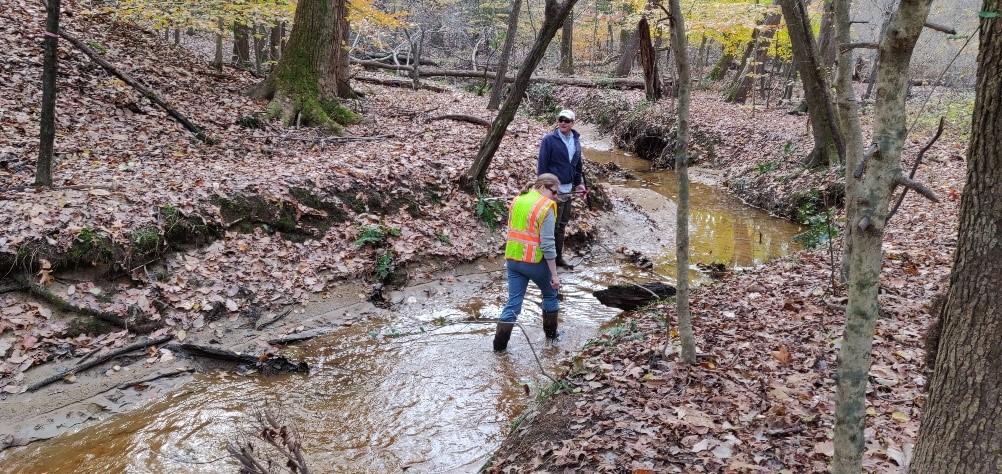Since European settlers arrived in Anne Arundel County around 400 years ago, human activities have had a profound impact on the streams and rivers that flow through our landscapes. Beginning with the removal of upland forests and conversion of these areas to farm fields, followed by the continuing slow transformation to developed land, land cover changes have at different times resulted in the tremendous movement of soil from upland areas into stream channels and the valleys through which they flow, burying these pre-Colonial plant and animal communities and possibly altering the character and form of these receiving streams. These "legacy sediments” are thought to fill floodplains across the Chesapeake Bay and are believed to make up a significant fraction of sediment currently delivered to the Bay.
An incised stream cutting through a likely legacy sediment deposit. While it is known that most of the Chesapeake Bay watershed was once covered by dense forest, when it comes to Coastal Plain streams and their surrounding valleys, scientists are unsure of what these areas looked like in pre-Colonial times. Historic accounts of stream valleys in the Piedmont physiographic region describe these places as full of swamps, springs, and meadows. It is also known that beaver (Castor canadensis) was prevalent all over the Eastern US and that this species had profound impacts on streams through dam building and foraging activities. In contrast to the Piedmont floodplain swamp paradigm, many stream valleys in Anne Arundel County today typically contain a single stream that meanders its way across a floodplain area which has possibly been impacted by legacy sediment delivery, as shown in the adjacent photo. Beavers have all but disappeared from the landscape.
Research done over the last 10 years in Piedmont seems to confirm this picture of a beaver-mediated, floodplain swamp system buried under these legacy sediments. However, very little rigorous investigation has been done to determine the prevalence, and possible impacts, of these sediments on channel form in the Coastal Plain region. In contrast to Piedmont, there is a dearth of information on the pre-Colonial streamside ecosystem and historic channel form under these sediments. Anne Arundel County has partnered with the US Geological Survey to characterize this historic condition through a variety of assessment methods including radioisotope dating of the soil layers, identifying pollen and other plant materials found in the soils layers, and using trenching and other methods to identify the form of the historic stream channel underneath these legacy sediments.
Project Status
The following activities have occurred since project inception:
- Site locations and photography from the County’s Biological Monitoring Program were provided to USGS for use in preliminary site selection work.
- Using County spatial data sets, USGS performed a GIS-based examination of changes in stream channel elevations to screen possible sites.
- USGS, assisted by County staff, conducted a series of field visits at approximately 30 candidate sites, where they collected and analyzed soil and pollen samples from some of the more promising potential locations.
- At seven sites, wood stumps that were buried in channels were identified using visual and cellular examination techniques.
- Additional preliminary pollen and macrofossil assessment work will be done on sites without buried wood features to see if there are any differences between sites with buried wood and sites without this feature.
- Bureau of Watershed Protection and Restoration staff in conjunction with USGS are working to finalize the selection of a least two sites for inclusion in this study.
- It was decided by USGS and County staff that some resources from the geotechnical work will be shifted to more pollen and macrofossil identification, which will allow for more sites to be characterized and provide a better understanding of the pre-colonial streamside community.

